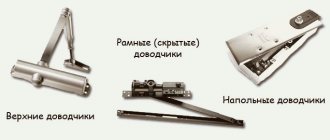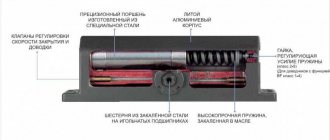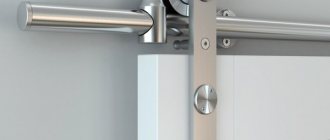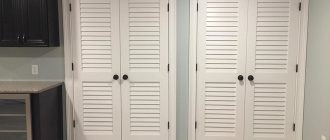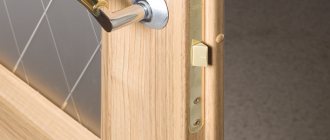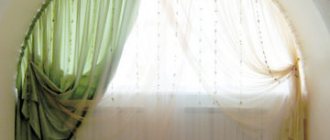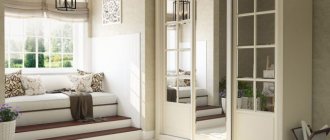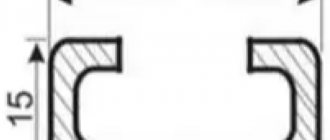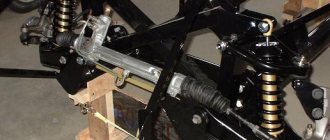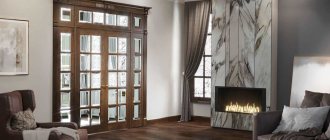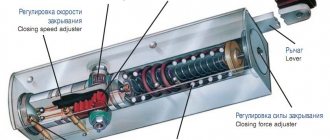Currently, all furniture is equipped with modern fittings, which increase the usability of cabinets and significantly extend their service life. The main element of the fittings, in addition to handles and hinges, was the cabinet closer. The device facilitates the smooth closing of the cabinet door, which completely eliminates sharp clicks and knocks.
Closer on kitchen cabinet
Operating principle of a sliding door closer
Closers for compartment doors are mechanical devices that prevent sudden collisions of door leaves. Structurally, the product is a metal body that houses a damper, a lever and a piston system. On its outer surface there is a special adapter that has an auxiliary effect on the operation of the closer.
When the sash is closed, the adapter presses on the lever, which causes the damper to operate. As a result, the door slows down, and when the damper reaches its final position, the leaf stops completely. Damping the sliding door closer helps to absorb the applied force, so the door closes without a characteristic knock or force blow.
Installation of a sliding door closer can be carried out with a closer in one direction or in both directions. As a rule, the devices are designed for door structures weighing 60–100 kg, made of laminated panels, PVC, veneer, glass, aluminum profiles, solid wood. Most often, they are installed in high-traffic areas, where constant opening and closing of the door leaf leads to a rapid loss of functionality of the entire door system.
On a plastic door
Installing a door closer on plastic is done in the same way. The difference is the lighter weight of the canvas. A compromise may have to be made between door closer power classes corresponding to size and weight. It is generally accepted that you should choose the larger of the two classes, but an overly powerful closer can destroy the plastic.
If the installation of a closer on a plastic door is done correctly and carefully, it will help prolong its operation.
Types of door closers
The range of door closers for compartment doors is not as wide as for conventional swing systems, but it is quite enough to choose exactly the option that suits best. The devices differ in the installation method, mechanism design, location on the door, as well as in design, color and price category.
By installation method
Depending on the installation method, there are two types of sliding door closers:
- Overlays - mounted on the outer surface of the door leaf, with most of their components open for access.
- Built-in – installed in the door profile, door frame or floor. In most cases, such products require creating a cutout in the structure using a cutter, into which the housing with the mechanism is inserted.
By location
Different types of door closers for compartment doors can be located in different places in the door system. Based on where the products are mounted, they are divided into two categories:
- Upper – for placement at the top of the door structure.
- Bottom - mounted at the bottom of the door.
According to the operating principle
The operation of all devices is based on a spring design, however, the principle of their operation may vary slightly depending on the structural features of the mechanism. In this regard, the following sliding door closers are distinguished:
- On a standard sliding rod, the lever moves simultaneously with the sash along a special groove.
- “Knee” - the lever has a folding structure and consists of two axes that bend like a knee when the sash turns.
- On the cam - the design has a cam that, when turned, exerts pressure on the spring.
- Toothed - products are equipped with a rack and pinion mechanism that acts on a spring.
Consumers are offered a wide range of additional devices that allow them to ensure full operation and smooth operation of the sliding door. In particular, the catalog of the TBM-Market online store presents high-quality universal rollers with a closer, designed to move the web in two directions.
Hettich Push-to-open system
The Push-to-open series of systems for opening furniture facades by the famous German manufacturer Hettich provides absolutely all options for pusher pushers:
- Push to open Magnet. Standard magnetic pusher with self-adhesive striker included. Additionally, you can purchase an adapter for surface mounting and a strike plate with a coupling if the adhesive base is not acceptable for some reason. Recommended for use in combination with hinges of the same series. Designed for small doors, 300-600 mm wide and 300-900 mm high.
- Push to open Magnet XL . Unlike the previous version, the reinforced magnetic pusher is equipped with a stepless gap adjustment system (2.3-5.3 mm). Can be used for installation on doors 300-600 mm wide and 900-1600 mm high.
- Push to open Pin . An interesting model of the stop-latch “in reverse”, when the applied capsule is installed on the side of the body, and the pusher itself is mounted on the inside of the facade. Without magnet. Recommended for use in combination with Push to open hinges. Designed for a substantial weight of facades, 300-600 mm in width and up to 300-2400 mm in length.
- Push to open Universal maxi. A universal pusher without a magnet, which can be installed on facades with any furniture hinges.
Advantages of using door closers
The benefits of installing a sliding door closer are beyond doubt. The device promotes soft, silent operation of the blade and provides many advantages in use:
- Protects the door from impacts when closing. Strong pops often lead to mechanical damage to the canvas and disrupt living comfort. If you install such a device, then you don’t have to worry that due to the high application of force, the door will fail prematurely or interfere with the peace of neighbors and household members.
- Guarantees the safety of the door leaf during operation. If the mechanism is adjusted correctly, the door closes softly and smoothly, so no one will get his fingers or clothes pinched.
- Reduces heat loss in the room. Automatic closing of the sash helps retain heat during the cold season and prevents the penetration of drafts. During operation, door closers for compartment doors tightly press the door leaves against the frame, ensuring good sealing of the room.
- Allows you to adjust the speed of movement of the sash. Many models offer assist features such as adjustable speed and selective closing force, allowing you to adjust their operation depending on the season. In particular, in winter they will close faster, minimizing possible heat loss.
Cabinet closer: do-it-yourself selection and installation
Currently, all furniture is equipped with modern fittings, which increase the usability of cabinets and significantly extend their service life. The main element of the fittings, in addition to handles and hinges, was the cabinet closer. The device facilitates the smooth closing of the cabinet door, which completely eliminates sharp clicks and knocks.
Closer on kitchen cabinet
Criterias of choice
When planning to purchase a sliding door closer, it is advisable to pay attention to its technical characteristics, which can be found in the attached instructions. Products with incorrectly selected parameters can lead to premature wear of door hardware and significantly reduce the functionality of the door leaf, therefore, when choosing a device, it is recommended to consider the following criteria:
- The type of traction mechanism installed in the housing - as mentioned above, modern manufacturers present to the market door closers with several types of mechanisms, which largely determines the location of their installation. In particular, devices with a standard rod are mounted directly on the door leaf, and devices called “elbow” are mounted on the door frame.
- Door dimensions - the wider and more massive the door leaf, the more powerful you should choose a door closer for compartment doors.
- Temperature conditions - many products operate smoothly in the range of -40...+70 °C, but some models lose their technical properties at low temperatures. For this reason, when purchasing a mechanism for unheated rooms, you need to take into account its operating conditions.
- Installation method - for glass doors it is advisable to buy devices with a floor mounting method; for all others, both floor and top mounting are suitable.
- Design – to ensure that sliding door closers fit perfectly into the overall interior design, it is best to give preference to kits that match the color palette of the door structure.
- Maintainability - if the structure fails, it should be easily replaced with a new one. In the catalog you can find universal sets of rollers with closers, suitable for all types of coupes. Our qualified employees will help with the purchase and organize its delivery in Moscow and the region.
Installation instructions for the finishing mechanism
When installing the finishing mechanism on interior doors yourself, rack structures equipped with a lever mechanism are usually used. Devices equipped with a slider rod are rarely used for such purposes.
Hidden closers are used for glass door blocks. Rarely for other door designs. They are also used if necessary to maintain strictly the interior of the room.
The installation technique for all types of finishing structures is practically no different.
Definition of installation diagram
First of all, the procedure for installing a door closer on your own is determined. The installation technique will differ depending on the direction of opening of the door leaf:
- The canvas opens to the finishing device. In such a situation, the body is mounted on the canvas, the lever mechanism on the box;
- The sash opens from the closer. The body is mounted on the door jamb, a sliding channel is fixed to the door leaf;
- It is also necessary to take into account that the adjusting bolts are placed in the direction of the door hinges.
Using a template
The product delivery package necessarily includes an installation diagram made in actual dimensions. The areas for fixing the product body and the lever mechanism are clearly marked on it. This makes it much easier to install the mechanism yourself.
At the same time, the template provides all possible options for attaching the door closer: for external and internal door opening, for right-handed and left-handed leaves. The template also suggests a class of door blocks for which the product can be used.
Performing installation
Before installing a closer on the door yourself without a specialist, a product template, which is included in the product package, is attached to the plane of the door leaf. It must be applied to the fastening area exactly according to the diagram and secured with transparent tape. After this, the points for drilling holes for fasteners are marked on the canvas using a center punch.
The procedure for installing the mechanism:
The housing is installed and secured with mounting bolts. Correct installation is determined by the position of the adjustment screws.
A lever structure is mounted on the opposite side of the door. Sometimes it is included in the package already assembled. The hinge is temporarily removed until the closer operation is adjusted.
Next, the knee is mounted - the non-adjustable part of the lever mechanism. To install the part, the axis of the finishing device is used. Fastening is carried out using a special wrench and nut.
If the door is expected to close silently and smoothly, the knee is fixed perpendicular to the door leaf, and the lever is fixed at an angle. The connection of the elements of the finishing device is carried out only with the door tightly closed. If the purpose of installing a closer is finishing force, then the rigid lever is fixed perpendicular to the door leaf. This installation scheme is used for doors with latches and seals.
At the next stage of installation, it is necessary to adjust the length of the adjustable elbow to the rigid mechanism. This technology makes it possible to strengthen the spring of the device and speed up the closing of the door when closing.
The final stage of self-installation of the finishing mechanism is the connection of the individual elements of the knee with a hinge.
If the model of the closing device is suitable for installation on door blocks made of any material (steel, wood, plastic), then the delivery set must include fasteners for all types of doors.
How to properly install a door closer on your own is shown in detail in the following video:
Features of non-standard installation
In some cases, it is necessary to use a non-standard technique for installing the finishing device on door blocks, for example, with a heavy metal leaf. For this, corners and plates are additionally used. Such fastening elements are already included in the package of individual products. But, often they have to be purchased separately.
In case of a deep entrance opening, which does not allow installation of a lever bracket on the frame, a construction angle is additionally used. Sometimes it is used to mount the housing and working system.
Installation of the housing is not always possible due to the design features of the door block. For example, the door block is equipped with a high glass insert. In such situations, the device body is mounted on a special plate. They are also used for leveling and fixing the body of the supply system when there is not enough space above the sash to fix the lever mechanism.
The size of the plate is selected accordingly to the size of the finishing device and the type of door leaf construction. Therefore, when purchasing a product, it is recommended to additionally consult with the seller in the store.
Door closer installation
A regular overhead sliding door closer is easier to install, but a hidden one requires professional skills, dexterity and special tools. In general, to install any product you need to prepare a tape measure, level, drill and screwdriver. Before proceeding with installation, you should mark the holes for fasteners, which are determined from the lower height of the doorway. Further installation involves performing the following actions:
- In the marked places, holes are drilled using a drill (if a hidden closer is installed, then cuts are made under the body).
- Before installing the door closer for compartment doors, tighten its carriage (bring it to an erected state).
- Using a screwdriver, screw the body of the product to the end of the canvas.
- Similarly, a hook is attached to the upper guide.
- Adjust the device. There are two screws on the body that are responsible for the speed and force of closing the sash. They are carefully turned until the required door operating parameters are achieved.
If the installation of the mechanism is carried out correctly, the sliding door closer will last a long time and reliably protect the premises from drafts and extraneous noise. Its use will ensure smooth closing of the door and will make operating the compartment more comfortable and easier.
How much is silence worth? Furniture closers for cabinets
Aesthetics, good quality materials and thoughtful ergonomics are the three main criteria for choosing any furniture. The type of fittings used to equip the cabinets and drawers is also of considerable importance. Almost all modern furniture of a higher than average class is produced with closers - special soft closing mechanisms. However, not many people know that furniture closers for cabinets can be installed on finished and purchased furniture, for example, after updating it yourself. And they are not that expensive. But using furniture in which doors silently open and close is much more pleasant.
